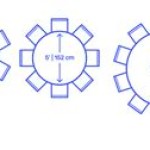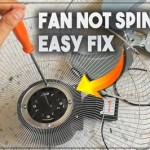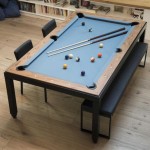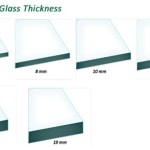Standard Billiard Table Size In Meters: A Comprehensive Guide
Billiard tables, a staple in recreational spaces and competitive venues, come in various sizes. Understanding the standard dimensions, particularly when expressed in meters, is crucial for both prospective buyers and players seeking a consistent playing experience. This article delves into the standard billiard table sizes, converting imperial measurements to metric, and explaining the significance of these dimensions in gameplay and space requirements.
Regulation Sizes and Metric Conversion
The term "billiard table" often encompasses several related games, including pool, snooker, and carom billiards. Each of these games typically uses a different table size, although there can be overlap. For pool, specifically, two primary regulation sizes exist: 7-foot and 8-foot tables. In professional pool tournaments, 9-foot tables are the standard. Each of these sizes translates to specific metric equivalents. It is important to note that these dimensions refer to the playing surface and not the overall external dimensions of the table.
A 7-foot pool table has a playing surface of 76 inches by 38 inches. Converting these measurements to meters, the playing surface is approximately 1.93 meters in length and 0.97 meters in width. An 8-foot pool table has a playing surface of 88 inches by 44 inches. Converting this to metric units, the playing surface is approximately 2.24 meters long and 1.12 meters wide. A 9-foot pool table, used in professional tournaments, has a playing surface of 100 inches by 50 inches, which equates to approximately 2.54 meters in length and 1.27 meters in width.
Beyond these standard pool table sizes, snooker tables present a significantly larger scale. The traditional full-size snooker table measures 12 feet by 6 feet, which is equivalent to approximately 3.66 meters in length and 1.83 meters in width. While smaller versions of snooker tables exist, professional matches are invariably played on full-size tables.
Carom billiard tables also have standardized dimensions. The typical carom table measures 5 feet by 10 feet, converting to approximately 1.52 meters by 3.05 meters. This elongated shape influences the gameplay dynamics, focusing on strategic positioning and cushion shots rather than pocketing balls.
It's important to consider that the dimensions provided are for the playing surface, the area within the cushions. The overall table size, including the frame and rails, will be larger. Therefore, when planning a space for a billiard table, one must account for the extra area occupied by the frame. This "footprint" is critical in ensuring comfortable gameplay with adequate room for players to maneuver around the table.
Impact of Table Size on Gameplay
The size of a billiard table directly impacts the gameplay experience. Smaller tables, like 7-foot models, are often preferred for home use where space is limited. These tables allow for faster-paced games and are more forgiving to novice players due to the shorter distances between balls and pockets.
Larger tables, such as 9-foot models, offer a more challenging and strategic gameplay experience, mirroring the conditions found in professional tournaments. The increased playing area demands greater precision in shot-making, positioning, and cue ball control. Longer shots and more complex angles become commonplace, testing the player's skill and strategic planning abilities.
The selection of a table size should align with the player's skill level and playing preferences. Beginners might find smaller tables more accessible for learning the fundamentals, while experienced players seeking to refine their skills may opt for larger tables to simulate competitive environments. The table size also determines the spacing between balls, influencing the angles available for shots and the overall difficulty of the game.
Furthermore, the choice of table size affects the type of game that can be played comfortably. While pool variations can be accommodated on smaller tables, certain games with complex patterns and numerous balls, like 9-ball, benefit from the larger playing surface offered by 8-foot or 9-foot tables. Snooker, with its larger table and more balls, is inherently suited to its designated regulation size.
The table's dimensions also dictate the required clearance around the table. Players need sufficient space to comfortably maneuver and execute shots from various angles. Insufficient space can hinder gameplay, restricting shot options and leading to awkward or compromised stances. Therefore, it is essential to carefully assess the available space before selecting a billiard table to ensure a comfortable and enjoyable playing environment.
Space Requirements and Room Dimensions
Beyond the table's actual dimensions, adequate space is crucial for comfortable gameplay. A general guideline suggests allowing at least 5 feet (approximately 1.52 meters) of clearance around all sides of the table. This clearance allows players to comfortably use a standard-length cue (typically around 58 inches or 1.47 meters) without obstruction.
To calculate the minimum room size required, add twice the cue length to the table's length and width. For example, for a 7-foot table (1.93 meters x 0.97 meters) using a standard 1.47-meter cue, the minimum room dimensions would be approximately 4.87 meters (1.93 + 2 * 1.47) in length and 3.91 meters (0.97 + 2 * 1.47) in width. Similarly, for a 9-foot table (2.54 meters x 1.27 meters), the minimum room dimensions would be approximately 5.48 meters in length and 4.21 meters in width.
These calculations provide a bare minimum clearance. Ideally, more space should be allocated to accommodate multiple players, seating arrangements, and other furniture or equipment. Restricted space can lead to compromised shots, player discomfort, and ultimately, a less enjoyable playing experience. A larger room allows for greater freedom of movement and more strategic shot-making possibilities.
It's also important to consider the ceiling height. Low ceilings can interfere with shots, particularly bridge shots where the cue is elevated. A minimum ceiling height of 8 feet (approximately 2.44 meters) is generally recommended, although higher ceilings are preferable, especially for taller players or those who frequently use elevated shots.
When assessing a space for a billiard table, consider potential obstructions such as columns, doorways, or furniture. These obstacles can limit the playing area and necessitate adjustments to the table's placement. Careful planning and measurement are essential to ensure that the chosen table size fits comfortably within the available space and provides an optimal playing environment.
In summary, understanding the standard billiard table sizes in meters, along with the corresponding space requirements, is crucial for making informed decisions about table selection and room planning. By considering the table's dimensions, the impact on gameplay, and the necessary clearance for comfortable movement, one can create a billiard room that is both functional and enjoyable.

The Official Size Of A Pool Table Canadian Home Leisure

Pool Table Room Size Calculator

What Size Room Will I Need For My Snooker Table Liberty

What Is The Ideal Room Size For A Pool Table Use Our Calculator Home Billiards S

Room Size For A Pool Table

What Room Size Do I Need For My Pool Table Liberty

What Room Size Do I Need For My Pool Table Liberty

Pool Table Room Size Guide Home

Layout Of A Pool Table Billiards Snooker And Darts Te Ara Encyclopedia New Zealand

Mehlschwitze Tempel Entfernung Room Size For Pool Table In 46 Off








